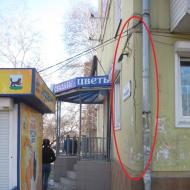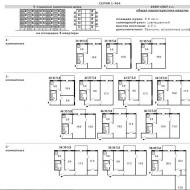
Types of plastic cards and their features. Bank card. What is a bank card
Plastic cards occupy a significant place in the settlement system of many industrialized countries. In recent years, various types of plastic cards have begun to be used in Russia.
Plastic card- is a plate of standard sizes (85.6 mm, 53.9 mm, 0.76 mm), made of special, resistant to mechanical and thermal influences, plastic. From the above, it can be seen that the main function of a plastic card- ensuring the identification of the person using it as a subject.
Classification of bank plastic cards
There are many signs by which plastic cards can be classified.
By the material from which they are made:
- paper (cardboard);
- plastic;
- metal.
Nowadays, almost ubiquitous plastic cards have spread... However, paper (cardboard) cards sealed in transparent foil are often used to identify the cardholder. These are laminated cards. Lamination is a fairly cheap and easily accessible procedure, and therefore, if the card is used for calculations, then in order to increase the security against counterfeiting, a more advanced and complex technology for making cards from plastic is used. At the same time, unlike metal, plastic is easy to heat treatment and pressure (embossing), which is very important for personalizing the card before issuing it to the client.
General purpose:
- identification;
- informational;
- for financial transactions.
This division is not mutually exclusive. For example, big company can issue each of its employees a card that:
- is a pass that allows access to certain areas of the enterprise (identification function);
- on the same card, any important information about the cardholder can be recorded in a coded form - information function;
- in addition, such a card can also be used for payments in canteens and stores of this company - a settlement function.
System using multifunctional cards really exists abroad, and it is obvious that combining many functions in one plastic card is promising, since such a multifunctional card is convenient for the issuer and for the holder.
Based on the settlement mechanism:
- bilateral systems- arose on the basis of bilateral agreements between settlement participants, in which cardholders can use them to purchase goods in closed networks controlled by the card issuer (department stores, gas stations, etc.);
- multilateral systems- provide cardholders with the opportunity to buy goods on credit from various merchants and service organizations that recognize these cards as a means of payment. Multilateral systems are led by national bank card associations and tourism and entertainment card companies (eg American Express).
By the type of calculations performed:
- credit cards , which are associated with the opening of a line of credit at the bank, which enables the owner to use the loan when buying goods and receiving cash loans. A special card account is opened for the owner of a credit card and a credit limit is set on the loan account for the entire validity of the card and a one-time limit for the amount of one purchase; within the one-time limit, payment for the purchase can be made without authorization;
- debit cards are designed to receive cash from ATMs or to pay for goods with payment through electronic terminals. In this case, the money is debited from the cardholder's bank account. Debit cards do not allow you to pay for purchases in the absence of money in the account.
Some authors distinguish payment cards in a special category as a kind of credit cards. The difference is that the total amount of debt when using payment card must be repaid in full within a certain time after receipt of the statement without the right to extend the loan.
By the category of clientele that the issuer is targeting:
- regular cards;
- silver cards;
- gold cards.
Regular cards are intended for an ordinary client. These are Visa Classic, Eurocard / MasterCard Mass (Standard).
Rice. 14. Visa Classic and Eurocard / MasterCard MassA silver card (Silver, Business) is called a business card and is intended for individuals, employees of companies authorized to spend within certain limits of their company's funds.

Gold card (Gold) is intended for the most affluent wealthy clients.

VISA and Europay systems have cards that can only be used at ATMs for receiving cash and in electronic terminals: Visa Electron, Cirrus / Maestro. They operate within the limits of the account balance, as a rule, no credit is provided to the cardholder, and therefore they can be issued to any client, regardless of his level of security or credit history.
By the nature of use:
- individual card issued to individual bank customers can be standard or gold;
- family card issued to family members of the contracting party who is responsible for the account;
- corporate card issued to a legal entity, on the basis of this card may be issued individual cards selected individuals (managers, chief accountant or valuable employees). They open personal accounts "linked" to a corporate card account. The organization, and not the individual holders of corporate cards, is liable to the bank for the corporate account.

By affiliation with the issuing institution:
- bank cards issued by a bank or a consortium of banks;
- commercial cards issued by non-financial institutions: commercial firms or a group of commercial firms;
- cards issued by organizations whose activity is directly the issue of plastic cards and the creation of infrastructure for their service.
By area of use:
- universal cards are used to pay for any goods and services;
- private commercial cards are used to pay for a specific service (for example, cards of hotel chains, gas stations, supermarkets).
By territorial affiliation:
- international, valid in most countries;
- national, acting within any state;
- local, used on a part of the territory of the state;
- cards valid in one specific institution.
By time of use:
- limited by any time interval (sometimes with the right to prolong);
- unlimited (unlimited).
By the method of recording information on the card:
- graphic recording;
- embossing;
- bar coding;
- magnetic stripe coding;
- laser recording (optical cards).
The earliest and simplest form of recording information on a card was and remains graphic image... It is still used in all maps, including the most technologically sophisticated ones. Initially, only the surname, name of the cardholder and information about its issuer were printed on the card. Later, a sample signature was provided on universal bank cards, and the surname and name began to be embossed (mechanically squeezed out).
Embossing- application of data on the card in the form of embossed signs. This made it possible to register a card payment operation much faster, making an imprint of a slip on it. The information embossed on the card is instantly transferred to the slip. The method of transferring the information embossed on the card is mechanical pressure. The embossing did not completely supplant the graphic image.
Bar coding- recording information on a card using bar-coding was used before the invention of the magnetic stripe and did not receive distribution in payment systems. Cards with barcodes, similar to those that are applied to goods, are quite popular in special card programs where calculations are not required. This is due to the relatively low cost of such cards and reading equipment. At the same time, for better protection, barcodes are covered with an opaque layer for the naked eye and read in infrared light.
Magnetic cards have the same look as ordinary plastic cards, only there is a magnetic stripe on the back of the card, and a photograph of the holder and a sample of his signature are also possible.
See further:It is clear that the magnetic stripe no longer provides the required level of information protection against fraud and counterfeiting. Experts began to look for a more reliable way of recording information. It turned out to be chip(from the English chip - a crystal with an integrated circuit) or microcircuit. Chip cards are also often referred to as smart cards.
See further:In 1981 J. Drexler was invented optical card... Optical memory cards have a higher capacity than memory cards, but data can only be written to them once. These cards use WORM (write-once-read many) technology. Recording and reading information from such a card is performed by special equipment using a laser (hence the other name - laser card). The technology used in cards is similar to that used in laser discs. The main advantage of such cards is the ability to store large amounts of information. Such cards have not yet become widespread in banking technologies due to the high cost of both the cards themselves and the reading equipment.
Details and means of protection of international bank cards
|
EUROCARD / MasterCard |
SBERBANK - MAESTRO |
|||||
|
Old design |
New design |
Old design |
New design |
Old design |
New design |
|
| Front side | ||||||
|
Logo payment system(emblem) |
In the upper right or lower right corners - a three-color rectangle consisting of horizontal stripes of blue, white and yellow with the word VISA in blue on a white stripe. Along the perimeter of the logo there is a microtext containing the first four digits of the card number and the code of the issuing bank (may consist of letters and numbers) |
EUROPAY INTERNATIONAL:
INTERNATIONAL: two intersecting red and yellow circles with a white MasterCard over the circles |
In the lower right corner under the hologram there is the Maestro logo in the form of two intersecting circles of blue and red colors with the Maestro inscription in white paint |
|||
| Hologram | On the right side of the map, in the center, there is a volumetric mirror image of a flying dove. When you turn the card from right to left, the left wing of the pigeon increases, the right one falls (the pigeon flaps its wings) | Against the background of horizontal lines containing the word MasterCard, executed in microtext, three-dimensional images of the hemispheres of the globe, on which, when the map is rotated, the grid of parallels and meridians changes to the outlines of continents | Two intersecting flat circles with three-dimensional images of moving continents against the background of horizontal lines containing the word MasterCard. The outlines of the circles are made with microtext containing repeating MasterCard symbols | A three-dimensional image of the trademark of the Security Council of the Russian Federation with the inscription Sberbank of Russia in white over it against the background of alternating horizontal lines consisting of the inscriptions Sberbank of Russia and Sberbank | ||
| Issuing bank logo | the top part of the card in the right or left corners - the inscription SBERBANK in black printing ink | In the upper right corner of the map there is an inscription SBEBANK OF RUSSIA in black ink | ||||
| Number | Starts with a number 4, divided into 4 groups, consists of 16 digits (4-4-4-4) or 13 (4-3-3-3) with the last group of digits on the hologram |
Starts with number 5, is divided into 4 groups, consists of 16 numbers (4-4-4-4) with the last group of numbers on the hologram | Consists of 18 digits, divided into 2 groups (810 digits) with the last 4 on the hologram | |||
| Deadline data actions |
Start date and end date are embossed possible use maps in month / year or month / day / year format (10/02 or 10/15/02) | Only the expiration date is embossed in the month / year format (12/02) | ||||
| Information about the bank that issued the card | On VISA cards (Classic, Cold), Sberbank-Maestro, 8 or 9 digits are embossed in the format XXXXYYYYY (XXXX is the branch number, YYYYY is the branch number). This line is absent on VISA Business, Eurocard / MasterCard Business cards | |||||
| Holder data | The name and surname of the cardholder are embossed (it is possible to apply the personal data of two persons) in Latin script. On corporate cards the name of the organization can be embossed in Latin letters. | The name and surname of the cardholder are embossed (IVAN PETROV) | ||||
| Microprinting | In the frame of the logo, the first four digits are the card numbers and the code of the issuing bank (from numbers and letters) | On the bottom layer of the hologram in horizontal lines there is the word MasterCard | MC is repeated in the contours of the circles of the hologram | No | ||
| Four-digit number | It is printed with indelible ink in a contrasting color above or below the 1st group of digits of the card number. The printed digits must completely coincide with the 1st group of digits of the embossed card number | It is printed with indelible and contrasting color of the card with paint under the first digits of the embossed card number and completely coincides with the first four digits of the card number | No | |||
| Image in UVL | In the center of the map is a blue-violet (for SB RF cards) or pink image of a flying pigeon | At the bottom of the card there are letters M and C: M - in the left corner and through a gap in the middle - C | No | |||
| Special symbols |
Beyond the card expiration date: The symbol V (flying V) is embossed, which has a non-standard format tilted to the right, with limited upper undershoots directed to the left; Pairs of letters CV, PV, BV are embossed; C, P, B are printed + V is embossed |
After the expiration date of the card, a sign (floating M) is embossed, consisting of elements of the letters M and C | No | |||
| Downside | ||||||
| Panel for sample signature of the cardholder | White strip filled with diagonal lines with the word VISA in blue / blue (for cards from third-party issuing banks). When trying to forge a sample signature, spaces appear | A white strip filled with diagonal lines with the word VISA in blue / blue and gold and a 19-digit number printed in a special font with a slant to the left, which includes 16 digits of the card number and 3 digits security code. When trying to forge a sample signature, spaces appear. The word void appears in spaces - not valid |
White strip filled with diagonal lines with the word MasterCard or MC in red, blue and yellow colors and a 19-digit number printed in a special font with a slant to the left, which includes 16 digits of the card number and 3 digits security code. When trying to forge a sample signature, spaces appear. The word void appears in the cases - invalid |
White strip filled with diagonal lines with the word MasterCard or MC in red, blue / cyan and yellow colors and a 7-digit number in the center of the panel, printed in a special font tilted to the left, which includes the last four digits of the card number and 3 digits of the code security. When trying to forge a sample signature, spaces appear. The word void appears in spaces - not valid | White stripe filled with repeating zigzag lines and SAFESIG lettering. At attempt to forge the sample of the cardholder's signature, the lines and inscriptions are erased | |
| Magnetic stripe | A black or dark brown magnetic strip soldered into plastic, containing information about the cardholder, his account number, bank and additional encoded data applied electronically | |||||
Bank card Is the most convenient, practical and reliable payment instrument that has become an integral part of the life of a modern person. For many users, it not only gives access to its bank account, but also gives many opportunities in the form of discounts, bonuses and other privileges. Consider what a bank card is, what types of them exist.
Description
A bank card is a personal payment instrument that gives its owner access to his bank account, debit or credit. With its help, you can make non-cash payments for goods and services, including on the Internet, withdraw cash at the cash desks of banks or ATMs.
Bank cards appeared in human life not so long ago, only 60 years ago, today they are used all over the world and are gradually replacing cash. By the way, before the advent of "plastic", the system of cashless payments existed in the form of checkbooks, which has now become history completely.
A number of requirements are imposed on the plastic product of any issuing bank, first of all, the size according to the ISO 7810 ID-1 standard, namely, width - 86 mm, length - 54 mm, thickness up to 1 mm, corner radius - 3.18 mm.
Advantages
Compared to cash, cards provide their holder with a number of advantages:
- your money is reliably protected, because the funds are stored in a bank account, if you lose "plastic", then access to the account can be blocked, that is, the money is not on the card, but in the bank, which can be more reliable;
- convenient use, that is, when paying for goods and services, neither the cashier nor the buyer can make mistakes in the calculations, for example, give change incorrectly;
- the advantage abroad is that the money stored on the card does not need to be declared, which cannot be said about cash;
- income on debit accounts, most financial and credit organizations offer such a service as cash back, that is, this is money that is returned to the account from each purchase;
- finally, it is much easier for plastic owners to control their expenses, and therefore, to regulate the family budget, at any time the client can request an extract of the report, completely free of charge.
Varieties of plastic
A payment card is just a tool or a key to a bank account for your own or bank account. In the first case, the card is debit, that is, the user spends only his own funds, in the second, the card holder uses credit.
All bank cards are divided into several types according to the type of payment:
- debit - with own funds on the account;
- credit card - settlements on it are carried out at the expense of a loan, the limit of which is set by the bank;
- prepaid is "plastic", with a fixed amount on the account, unlike all other products, it is not issued, but is bought from the issuer;
- overdraft - this product with a permitted overspending on the client's account.
Not so long ago, banks began to offer customers completely the new product is a virtual card, unlike real "plastic" it does not have a physical medium. This product is useful for those who make purchases through online stores. The bank issues to the client only the details.

Bank card appearance
Appearance
So, what the card looks like, its design and the main elements on the front side:
- surname and first name of the holder in Latin characters;
- a 12-digit number, but there can be 18 or 19, depending on the issuing bank;
- the logo of the payment system that serves it, for example, Visa or MasterCard;
- microchip for additional protection;
- the logo of the issuing bank;
- "plastic" status, for example, standard, gold or platinum;
- expiration date, month and year.
On the back side:
- the logo of the issuing bank;
- magnetic stripe;
- owner's signature;
- CVV2 / CVC2 code for additional protection settlement transactions on Internet resources.
Perhaps not everyone knows, but the issue of plastic bank cards is regulated by the Regulation of the Central Bank of the Russian Federation "On the issue of bank cards and on transactions performed using payment cards."
How is the calculation done: mechanism
We all quite often use bank payment cards to pay for goods or services, but not everyone knows exactly how the settlement mechanism takes place between the issuing bank and the seller.
Consider this diagram:
- In case of non-cash payment, the buyer gives his card to the seller.
- Further, the seller must make sure of its authenticity and visually determine whether it is counterfeit, only after that the plastic passes through the terminal by means of a magnetic tape or microchip. The terminal reads the information by number and sends it to the acquiring bank (this is the organization that owns this device). The automatic system processes information about the cardholder, account limits and makes a decision to carry out the operation or refuse.
- In case of a positive decision, the acquiring bank accepts the payment and debits the funds from the account. The card and the check are returned to the owner, the second copy of which remains with the seller.
- Further, the seller sends a report on non-cash transactions to the acquiring bank, and he, in turn, transfers money to the organization's current account in the amount of non-cash transactions carried out per day.
- After that, the bank transfers the data to the processing center (a subdivision that provides information interaction between settlement participants, that is, banks). It processes information on transactions and sends it to banks for mutual settlements.
- The issuing bank pays with the acquiring bank independently.
The process of issuing cash through self-service devices - ATMs looks similar.

How is the settlement with a bank card: scheme
In general, what is a payment card? This is a means of non-cash settlement, which allows its owner to make any settlement transactions without using cash. At the moment, the most in demand are credit cards, that is, cards with a credit limit. They are primarily a spare wallet for their owner, and also allow you to use borrowed funds during a grace period without interest.
An increasing number of people use payment cards. Not surprisingly, they are easy to use and make life a lot easier. They allow you to make non-cash payments in stores and on the Internet, withdraw money from an ATM, and also have many useful functions (bonus program, access to discounts, access to an online bank). However, do you know how this small piece of plastic works, and what information should be on the front and back of a bank card?
All payment cards, no matter which bank issues them - they must be made of flexible plastic, have an identical format and contain certain elements.
Bank card sizes
Standard card sizes were defined in 1985 by ISO (International Organization for Standardization - Eng. International Organization for Standardization). According to the ISO / IEC 7810 standard, each payment card must be 53.98 mm high, 85.6 mm wide and 0.76 mm thick (this is the so-called ID-1 format). The card must have rounded edges with a radius of 3.18 mm.
Various details presented on the map and the location of some elements are also subject to standardization. In addition, the ISO standard defines a method for recording data in a magnetic stripe or a microprocessor (chip) built into a card.
Obverse - the front side of a bank card
In accordance with ISO standards, the following data must be indicated on the front (front) side of a bank card:
Name and brand name (logo) of the card issuing bank
This data is located at the top of the map: in the center or in the left corner.
Card number
The card number is located in the central part of the card and is a sequence of 16 digits written in 4 blocks of 4 digits. Contains information about the account of the cardholder, the bank that issued it and the payment system to which the card belongs.
First digit informs about the industry affiliation of the financial institution that issued the card.
For example:
- 1 and 2 are reserved for airlines
- 3 - for T&E club cards
- 4, 5 and 6 - for financial institutions such as Sberbank
- 7 - for a network of points of sale of fuel
- 8 - for telecommunication networks

Four, five and six indicate the payment system in which the card operates. 4 - VISA, 5 - for MasterCarda plastic, 6 - for regional payment systems.
Next 5 digits define financial institution that gave us the card.
First six digits are a BIN (Bank Identification Number), sometimes referred to as a "prefix".
Next nine digits- identifier of the account number of the client who is the cardholder.
Last sixteenth digit Is the so-called check digit, which is calculated based on the Luna algorithm. It allows you to check the correctness of the entered sequence of numbers.
The check digit serves an important function, especially during online transactions. When we enter the card number, our computer, based on an algorithm, makes instant calculations and checks the validity of the entry. An identical operation is performed by the computer receiving the data (that is, the seller's computer).
Because the check digit is an additional form of protection for online transactions cashless payments- we are not able to “falsify” the card number in such a way that the payment is debited from the account of another person.
Important! The card number does not match the bank account number.
The most common mistakes when entering numbers:
- one error: a instead of b (60% -95% of all errors)
- skipping or adding a digit (from 10% to 20%)
- swap adjacent numbers - the so-called Czech error (from 10% to 20%)
- twin errors: aa entered as bb (0.5% to 1.5%)
- replace adjacent digits: acb entered as bca (0.5% to 1.5%)
- twin errors of distant digits: aca as bcb (below 1%)
Card expiry date
The expiration date of the card is indicated by embossing at the bottom, under the card number. The current recording format is MM / YY (sometimes preceded by the words VALID THRU). On the cards of some banks, the initial date of the card's validity may also be indicated.
The validity period of payment cards is determined individually by each financial institution. Most often this is a period from a year to 3 years, however, there are also longer periods.
The card can be used until the last day of the month in which the validity period expires - after this period the bank issues new card before the old one expires.
Organization logo and hologram
Typically, the logo and hologram are located in the lower right corner of the card ( although recently some contributors have been placing a hologram of the issuing organization on the reverse rather than the front).
A hologram can be a picture or text that is laser etched onto a very thin, metallic film and which, depending on the tilt of the map, gives the impression of two or three dimensions.
For the first time the hologram was used by the MasterCard organization, and now it is used by all payment systems. Three-dimensional pigeon is placed on VISA cards, the MasterCard hologram contains the MasterCard inscription and the symbol of connected globes... Holographic do not allow falsifying the card using simple copying methods, therefore, the protection of bank cards is an important element.
Microprocessor (chip)
It has the shape of a square or rectangle located to the left of the card, under the logo and the name of the bank. The module is embedded using a special glue that chemically reacts with the plastic of the card, making it impossible to remove it without damaging the plastic.
Name and surname of the cardholder (optional)
The name and surname of the cardholder are placed in the lower left corner of the card. In the case of business cards on personal card instead of the name and surname of the owner, the name of the company can be placed.
Designation of the region of the card
Local (national) card- can only be used in the territory of the country where its publisher is located. The bank then sets up special information on the front side, for example, "Valid only in Russia".
Sometimes cards bearing the EUROCARD / MasterCard or VISA mark can be of the local type, intended only for use in the territory of a given country. Local cards cannot be used abroad, because when you try to make a payment, the bank automatically blocks it.
The international card is used to make transactions both in the country in which the issuer is located and abroad. It can be used at any point of trade and service or ATM that displays your card logo.
Card type
Each payment system provides payment cards designed for different types of clients (gold, prestigious, business, etc.). As a rule, these cards differ from others in their graphic design, for example, the gold background color is reserved for Gold cards, silver is reserved for Silver cards. Sometimes, however, the type of card is also indicated on the face in the form of letters.
Additional elements
The following elements can also be placed on the face of the card:
- owner's photo (optional);
- special characters like contactless payment symbol;
- an element of protection that is only visible in ultraviolet rays.
Reverse - the reverse side of a bank card
The reverse contains much fewer elements. The most important of these are:

Magnetic stripe
The magnetic stripe has dimensions of 12 × 86 mm and contains an encoded set of data about the cardholder and his account, as well as a personal an identification number PIN. It consists of three parallel magnetic stripes, information from which is read through a magnetic head installed in an ATM or terminal.
The first line contains the name and surname of the cardholder and information about the country and the bank that issued the card. On the second track, the card number, its validity period and the service code necessary for the proper execution of the transaction are recorded. And the third lane is used to store the bank's own information.
The magnetic stripe is additionally protected against counterfeiting by means of microprinting, as well as elements visible only in the rays of ultraviolet radiation.
Signature field
The signature field, that is, the silicone layer on which the cardholder leaves his signature. The field is also protected with design elements that are invisible to the eye or that can only be seen in ultraviolet rays.
In addition, a thin layer of transparent white ink is placed on the field, which forms the base for the signature. An attempt to remove the signature for the purpose of reapplication entails the removal of the base, then the inscription "card expired" will appear in this place.
CVC2 / CVV2 code
The three-digit code CVC2 / CVV2 is indicated right in the signature field. It provides security for remote transactions, in which there is no way to enter a PIN code... It is indicated on the card and is also stored in the bank's information system. It cannot be disclosed to third parties!
- CVC2 (Card Verification Code 2)- used to confirm remote MO / TO transactions on MasterCard cards.
- CVV2 (Card Verification Value 2) code- a three-digit code that allows you to identify the cardholder Visa cards Electron and Visa Gold.
- American Express Cards- a four-digit code is indicated on the front of the card.
MO / TO (eng. mail order / telephone order / internet-order) - operations without physical use of the card. Confirmed by entering the card number and other unique bank card data (owner's name, expiration date, CVC2 or CVV2 code).
Information about the card issuer (bank details)
The reverse side of the card also contains the address information of the card issuer and the phone number by which the card can be blocked.
Evolution of production and functionality of payment cards
Modern payment cards perform more and more functions and have a more complex design. Nowadays, most of them have an on-board chip containing memory and a processor, which allows storing more data than a magnetic stripe, and guarantees a high level of security during operations carried out by the user.
Development of modern information technologies makes it possible to implement innovative solutions such as a card with a display that allows the user to check account balances and generate one-time passwords.
Another interesting idea is a card that allows you to use several bank accounts (you can select it by pressing a button on the card). Biometric cards with a built-in fingerprint reader and cards offering a dynamic (time-varying) verification code have also been successfully tested.
Time will tell if the new products will receive user acceptance. One thing is for sure - multifunctional payment cards can still surprise us with innovative solutions.
Before issuing "plastic", it is worth finding out what types of payment systems are and how they differ from each other? What level of security does each of them offer, and what profitability can the owner expect?

The popularity of banking plastic is growing every year. Cashless payments between organizations and individuals are also gaining momentum. Cards are much safer and more convenient than a wad of cash. Moreover, paper money does not give the owner all the advantages of plastic.
The first plastic card appeared in North America in the mid 50s. 20th century, thereby starting the replacement of checkbooks that have lost popularity. The magnetic stripe for removing information about the account is an invention dating back to 60 years, and the chip only appeared in the 90s. The tiny device contains the entirety of the cardholder's data, the state of his account and all the operations carried out.
In the Soviet Union, the history of plastic financial instruments begins with the gift of the first credit card to Gorbachev by a private bank, in 1967. Individuals Those who wished to own the novelty had to transfer $ 2 thousand to the financial institution.
Important! According to statistics, online fraudsters steal about $ 2.5 million from cards every day.
For the safety of customer savings, banks are constantly developing special protective programs. Recently, the idea of biometrics in the field of bank security has been gaining popularity. For example, identification with a card of the owner by fingerprints or a picture of the retina of the eye. But scammers do not sleep, often finding themselves one step ahead of official developments.

One of the first plastic cards
What is the difference?
Plastic media have basic characteristics that make them different. What are these characteristics? First, let's look at what kind of "plastic" is type of funds storage and how it works:
- Debit cards - for saving own funds owner. You can pay for purchases only if funds are available. Popular with employers for calculating employee benefits.
- Credit - provide a bank client with money for temporary use according to certain limits. You cannot go beyond these limits, otherwise you will have to pay interest or the percentage will increase. Usually, to popularize such cards, banks provide customers with an interest-free period of using funds, during which they can return money without costs.
- Overdraft - enable the owner to pay the bills, even if the funds are insufficient. The bank allows the client to exceed the limit, subject to the return of money at interest.
By class cards differ in the level of bonuses and services:
Payment systems
They, like maps, are divided into several varieties, based on the geography of use. Some make it possible to fully use a financial instrument in any country in the world, while others - only within the framework of their own state. Here is a list of existing PSs:
- Visa - configured for dollar transactions.
- MasterCard - focused on transferring funds in dollars or euros. By the way, MasterCard unites in a partner network about 1000 institutions more than Visa.
- Maestro is an exclusively Russian product developed and functioning in Russia.
- American Express - American cards that are accepted in almost every country in the world, but they are not widely used by Russians.
- WORLD is the youngest of all existing payment systems. Created in Russia to replace imported counterparts.
To find out which payment system the bank plastic belongs to, you don't need to look at the card logo. It is enough to know her number, or rather, its first digits. MIR card numbers begin with 2, with 3 for American Express, 4 - the first digit of the number of cards operating on the basis of Visa, 5 - indicates that the plastic belongs to the Master Card, 6 - to Maestro.

Additional map features
To attract as many depositors as possible to their products, banks regularly issue new, more sophisticated and high-tech plastic cards to the market. For example, co-branded the bank issues cards together with a partner company. When calculating with this tool, points are received on the client's account, which can later be used to pay for bank services or certain goods. Various promotions and special bonuses are also popular, for example, cards with installments or cashback.
Cashback - a return of a small percentage of the funds spent from the card.
How safe is modern "plastic"?
One of the constant concerns of the security service financial institution- this is the level of protection of bank plastic. Recently, new concepts have appeared in this area, for example:
How to avoid fraud?
Any bank client from time to time thinks about the security of his own account. It is no secret that modern fraudsters have in their arsenal various computer programs and other innovative tools to help hack cards. Therefore, when receiving a credit card, account holders try to use it only as a means of withdrawing cash. Meanwhile, observing several rules will help protect your plastic:
How does cashless payment work?
What is the procedure for cashless payments? The principle of operation is as follows:
- When making a purchase, the card is inserted into the terminal, which authenticates the plastic.
- Acquiring bank(that is, the institution responsible for the production of all operations on these cards) verifies the received data with those that are in the database.
- If no inconsistencies are found, a request is sent to the payment system.
- The system sends a request to the bank that issued the card (issuing bank) to find out information about the state of the account. Then the possibility of buying is established, and if there are enough funds, then the required amount is transferred to the seller's account.
- The terminal prints out two checks, the seller signs them and keeps one for himself, and gives the second to the buyer.
- At the end of the day, all data on funds transfers are sent to the acquiring bank, with which the store conducts recalculations.

Payment systems exist to provide the ability to conduct transactions on customer accounts. They ensure the interaction of several participants in the non-cash settlement process according to certain rules.
Card payment systems unite issuers, cardholders, service providers, processing centers, recipients of funds.
Electronic payment systems have clear advantages over cash payments. They help to increase turnover, speed up transactions, reduce costs and costs of transfers, while increasing their security.
Thanks to modern payment systems, transactions are carried out from anywhere in the world to anywhere almost instantly.
In most countries, several payment systems operate at the same time. Each of them occupies its own niche in the financial market and is intended for a specific category of users. RF is no exception.
Payment systems in Russia can be classified based on their structure and mechanism of action:
- by distribution: national and international;
- by form of ownership: state and private;
- by the amount of payments: wholesale and retail;
- for payment instruments: cash payments, electronic payments, card payments.
This is a generalized classification that can be divided into additional sections.
The spread of the electronic payment system evens out their differences. Now the most popular are considered mixed systems, bearing signs of several types.
Types of card payment systems
Card PS are allocated as a separate type of payments. Its peculiarity is the use of a plastic card when making a transaction. Cards, in turn, are divided into debit and credit cards with different parameters and capabilities.
The most popular card PSs in Russia are:
- Russian "MIR";
- international Visa MasterCard American Express.
Today MIR is just gaining its popularity and is not as popular as international ones.
1 Payment system Visa
The world's largest PS is at the same time the most widespread in the Russian Federation.
The official website of the company in Russia is www.visa.com.ru.
The system is distributed in more than 200 cities around the world, its clients are 30 million users of legal entities. The company serves over a million ATMs. The share of PS Visa in the world card circulation is 50%. The main currency is the dollar.
When carrying out operations, the innovative VisaNet processing system is used, which produces more than 65 thousand transactions per second.
Types of cards (each subsequent type provides new opportunities, including all the resources available for the product that is in the class below):
| Name | Characteristic |
| Electron | First level. It is used for online payments in electronic terminals. They are in demand among new users and students, young people. |
| Classic | The most common payment instrument. Payments can be made at all ATMs with the appropriate logo, on the Internet, in retail outlets. It is possible to make transactions online and offline. |
| Gold | Support in emergency situations during foreign trips and across Russia, consultations of doctors and specialists are provided if necessary, the availability of discounts, gifts for settlements in retail outlets around the world. |
| Platinum | Assistance if the card is lost while abroad, providing guarantees and protection of purchases, attending concerts, exhibitions and other events in the field of art free of charge and without queuing. Discounts are provided for hotel accommodation, when paying for car rental, spa services, dry cleaning, etc. |
| Signature | High status card. It is possible to get insurance free of charge when paying for the trip. We offer rooms in upscale hotels, discounts on jewelry, when paying for a taxi, etc. |
| Infinite | The ability to book tickets, choose restaurants, round-the-clock concierge services, discounts on visits to the water park, when buying furniture. |
Holders of cards of the Gold category and above receive additional features on premium cards... You can take advantage of special offers in partner companies located around the world.
2 Payment system MasterCard
The second largest PS in the world by turnover is MasterCard. The company's website in Russia is www.mastercard.ru.
The main currency is Euro. The system operates in over 200 countries around the world. The share of MasterCard in the world card circulation is about 25%. The card is convenient for use in European countries. Debit and credit cards are available. Using MasterCard, the owner gets access to additional services and opportunities.
|
Name |
Characteristic |
| Standard |
A popular payment tool that allows you to make payments, withdraw cash from ATMs with the appropriate logo. |
| Gold |
Priority service and special offers. |
| Platinum |
The ability to pay abroad and a wide range of special offers. |
| World |
The highest level of comfort, the availability of exclusive offers. |
| Mastercard Black Edition |
Exclusive design and additional privileges for wealthy owners. |
| World elite |
Endless possibilities around the world. |
PS capabilities:
- performing transactions by touching a card, a mobile phone;
- high security of payments;
- use of VIP lounges at airports;
- discounts in retail outlets, shops, cafes, restaurants, cinemas.
The higher the class of the card, the more privileges and opportunities its owner receives.
3 Payment system Mir
The development of the national PS in Russia began with the launch of the MIR card. Cards are issued with the support of the state, which ensures an increase in prestige national currency, provides attractive terms of service. You can use it in Russia and abroad. Site mironline.ru.
The card can be used in all retail outlets, withdraw cash from ATMs that bear the MIR logo. The possibilities of Internet acquiring are expanding. Security technology is provided by 3D Secure protocol version 2.0.
With the help of a payment instrument in the Russian Federation they receive wages public sector workers, pensions. The issue is free and has preferential service rates. Debit and credit cards are issued.
The first issuing bank was Sberbank, now the MIR product is produced by all credit companies in the country. So far it cannot compete with other PSs, but it is developing rapidly, governmental support ensures its relevance.
4 Payment system American Express
PS takes the 3rd place in the world card circulation, in Russia the website of the company is www.americanexpress.com.
Payment instruments of this PS are considered expensive and prestigious, intended for wealthy clients. A wide range of options are provided for a high fee.
| Name | Possibilities |
| American Express Card | A standard package of services is offered: transfers, payments, cash withdrawals, a guarantee for purchases, insurance when traveling abroad. The amount of compensation is up to 100 thousand dollars. There is a bonus payment system for goods. |
| RSB Travel Classic Set | For travelers. Discounts are available in stores worldwide up to 30%. Additionally, you can order MasterCart and link them to one account, which will allow you to accumulate more bonuses. |
| Platinum Debit Card | Monthly 1% is charged on the balance in foreign currency, 4% on rubles. With an average balance of more than 500 thousand rubles. (8 thousand US dollars, 7 thousand euros), the annual service is free. Insurance cover when traveling up to 500 thousand dollars. Concierge service, additional travel offers, providing world-class service. |
| The Platinum Card® | Unlimited use of VIP-lounges of airports with Priority Pass, free service at a turnover of more than 2 million rubles. in year. Accumulative bonus program |
| Gold Card | Insurance programs are provided, bonus programs, travel organization service. From the second year, free service, depending on the turnover on the account. |
How do payment systems work?
To work in the electronic PS, you first need to register on the site, get access to the system. Further, the user replenishes the account in any available way: by transferring funds from another card, by depositing cash, etc. Thus, he gets the opportunity to perform the necessary operations with the account.
In a simplified form, the PS operation process is as follows:
- The cardholder wishes to pay for the goods with a card of any PS in the online store. After choosing an item, he adds it to the basket and selects the payment method "Bank card", enters the necessary information and clicks "Pay".
- The acquiring bank reads the card data and sends a request to the processing center.
- After checking the card by the Center, the data is transferred to the issuer.
- The Issuer blocks the required amount on the account and transfers the data back through the Center to the acquirer.
- After confirmation of payment, a check is printed and the purchase is made.
The operation is performed in a few seconds thanks to modern technology.
The main differences between payment systems
The principle of operation, the main characteristics of the PS have no fundamental differences. Difference in market coverage, base currencies, prestige:
- In Russia, the leading position is occupied by VISA, then MasterCart.
- Basic VISA currencies and American Express - US dollar, MasterCart - euro, MIR - ruble.
- In terms of service, the most expensive and prestigious are American Express cards, the most economical in the WORLD.
Good to know: In terms of reliability, speed of operations, availability of additional options, international PS do not differ much. WORLD lags behind them, but is developing rapidly.
How to choose the right payment system?
There are several criteria for choosing a PS:
- Reliability and safety.
- Service tariffs.
- The ability to make payments in different currencies.
- Kudos, availability of additional features.
The program is selected depending on the individual needs of the user. For consumers who do not travel abroad, the MIR card is considered an affordable option. The scope of its application in Russia is quite wide, and the service rates are minimal.
VISA, MasterCart will suit all clients, depending on the status, it is possible to choose a card from a standard to a status card with good privileges.
American Express is necessary to emphasize their own solvency, security.
Federal law on payment systems
PS activities in Russia are regulated by Federal Law No. 161 dated 06/27/2011. It determines the procedure for the provision of payment services, the procedure for using electronic payments, determines the subjects of the national payment system, the requirements for the organization of their activities.
The fundamentals of the organization of the national system of payment cards, the formation of governing bodies and the council of participants are given.
The procedure for conducting inspections of supervised organizations has been determined.
Answers on questions
Which card should you choose to receive your salary?
Customers' salary cards are available in the range of all payment systems, you can choose at your discretion. Often employers independently conclude an agreement with a bank to transfer salaries to a card account. In this case, the user does not need to select anything.
Can I pay with any card over the Internet?
Yes, except Maestro cards... The ability to use Visa Electron for settlements is determined by the acquiring bank.
Output:
Payment systems operating on the territory of the Russian Federation have serious potential and great opportunities for development.
To get maximum opportunities, it is better to use the services of several PSs, using them depending on the situation.















